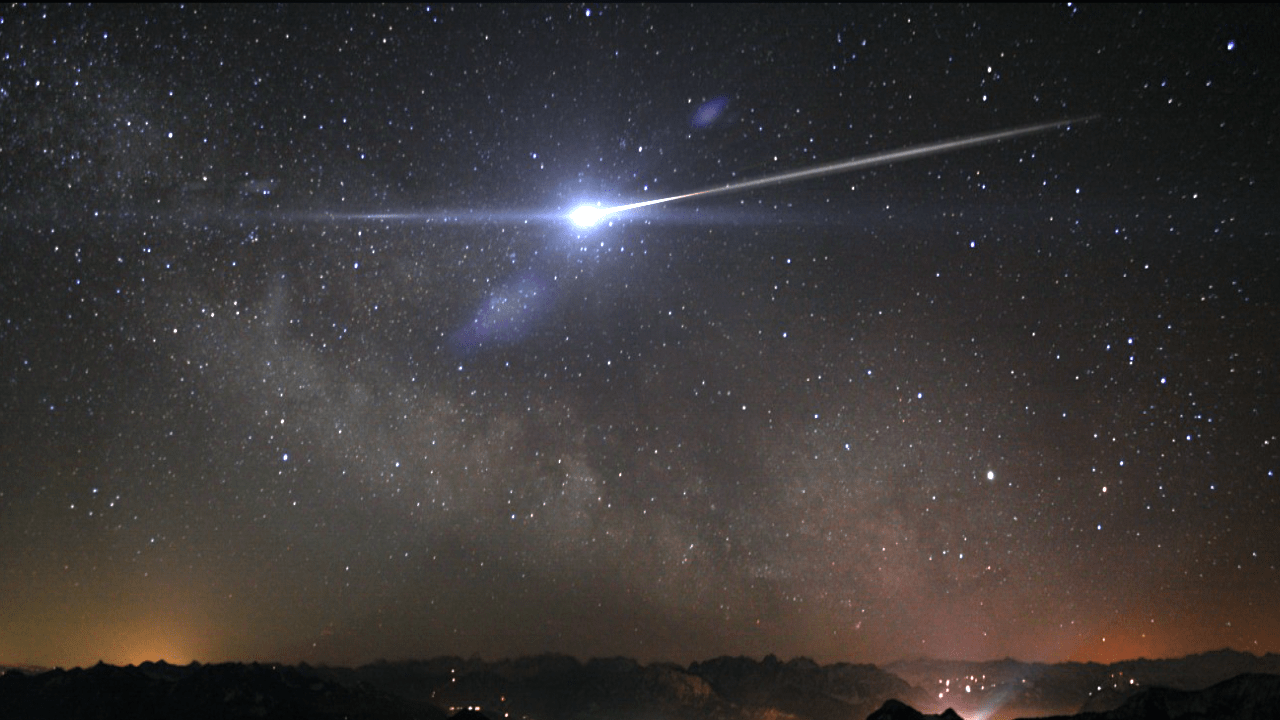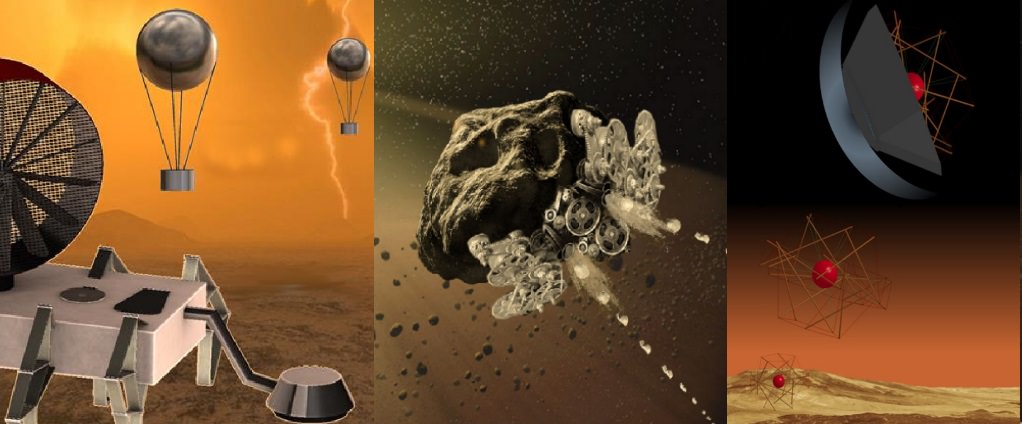The Moon has inspired poets and artists, musicians and playwrights. The sight of our one and only Moon is familiar to anyone that has ever glanced up at the night time (and sometimes day time sky!) Every so often though, our Moon (note the use of capital ‘M’)is joined by a small asteroid that wanders too close. Astronomers have detected an 11-metre wide asteroid that has the snappy name 2024 PT5 and it came within 567,000 kilometres of Earth and will become a temporary satellite from 29 September until 25 November when it will leave our system.
Continue reading “Earth Will Have a Tiny New Mini-Moon for a Few Months”NASA’s Says Goodbye to its Asteroid-Hunting NEOWISE Mission
NASA’s Wide-field Infrared Survey Explorer (WISE), launched in 2009, spent the next fourteen and half years studying the Universe in infrared wavelengths. During that time, it discovered thousands of minor planets, star clusters, and the first Brown Dwarf and Earth-Trojan asteroid. By 2013, the mission was reactivated by NASA as the Near-Earth Object Wide-field Infrared Survey Explorer (NEOWISE), which was tasked with searching for Potentially Hazardous Asteroids (PHAs). For ten years, the NEOWISE mission faithfully cataloged comets and asteroids that could pose a threat to Earth someday.
Unfortunately, NASA announced on July 1st that it would be decommissioning this planetary defense mission, which is expected to burn up in our atmosphere later this year. On Thursday, August 8th, the mission was decommissioned after the final command was sent from NASA’s Jet Propulsion Laboratory in Southern California and related to the spacecraft by the Tracking and Data Relay Satellite (TDRS) system. However, the scientific data NEOWISE collected during its ten years of operation will continue to inspire new discoveries!
Continue reading “NASA’s Says Goodbye to its Asteroid-Hunting NEOWISE Mission”A Few Interstellar Objects Have Probably Been Captured

When Oumuamua travelled through our Solar System back in 2017, people around the world paid attention. It was the first Interstellar Object (ISO) astronomers had ever identified. Then in August 2019, Comet 2I Borisov travelled through our Solar System, becoming the second ISO to cruise through for a visit. Together, the visiting ISOs generated a wave of inquiry and speculation.
There’s bound to be more ISOs than just those two, and a new study says our Solar System has probably captured some of these interstellar visitors, though they don’t stay for long.
Continue reading “A Few Interstellar Objects Have Probably Been Captured”Space Force is Releasing Decades of Tracking Data on a Thousand Bright Meteor Fireballs
When a meteoroid enters the Earth’s atmosphere at a very high speed it heats up. This heating up produces a streak of light and is termed a meteor. When a meteor is bright enough, about the brightness of Venus or brighter, it becomes a fireball. Sometimes these fireballs explode in the atmosphere, becoming bolides. These bolides are bright enough to be seen even during the day.
Studying bolides as they pass through the atmosphere can help model larger asteroids, something of interest to the Planetary Defense Coordination Office (PDCO) which is run by NASA. These asteroids can be deadly if they are large enough, and learning how to predict their behavior is essential to protecting our planet from a devastating impact with long-term implications for the survival of many species on Earth.
Continue reading “Space Force is Releasing Decades of Tracking Data on a Thousand Bright Meteor Fireballs”Hayabusa2 Fires an Anti-Tank Warhead at Asteroid Ryugu

Last week, the Japanese Aerospace Exploration Agency‘s (JAXA) dropped an explosive warhead on the surface of asteroid 162173 Ryugu. You might think this was the opening line of an entirely-readable science fiction novel, but it’s totally true. The operation began on April 4th, when the Hayabusa2 spacecraft sent its Small Carry-on Impactor (SCI) down to Ryugu’s surface and then detonated it to create a crater.
Continue reading “Hayabusa2 Fires an Anti-Tank Warhead at Asteroid Ryugu”Newly Discovered House-Sized Asteroid 2017 HX4 Flew Safely Past the Earth Yesterday

Yesterday (on May 8th, 2017), an asteroid swung past Earth on its way towards the Sun. This Near Earth Object (NEO), known as 2017 HX4, measures between 10 and 33 meters (32.8 and 108 feet) and made its closest approach to Earth at 11:58 am UT (7:58 am EDT; 4:58 am PT). Naturally, there were surely those who wondered if this asteroid would hit us and trigger a terrible cataclysm!
But of course, like most NEOs that periodically make a close pass to Earth, 2017 HX4 passed us by at a very safe distance. In fact, the asteroid’s closest approach to Earth was estimated to be at a distance of 3.7 Lunar Distances (LD) – i.e. almost four times the distance between the Earth and the Moon. This, and other pertinent information was tweeted in advance by the International Astronomical Union’s Minor Planet Center (IAU MPC) on April 29th.
This object was first spotted on April 26th, 2017, using the 1.8 meter Panoramic Survey Telescope and Rapid Response System (Pan-STARRS), located at the summit of Haleakala in Hawaii. Since that time, it has been monitored by multiple telescopes around the world, and its tracking data and information about its orbit and other characteristics has been provided by the IAU MPC.
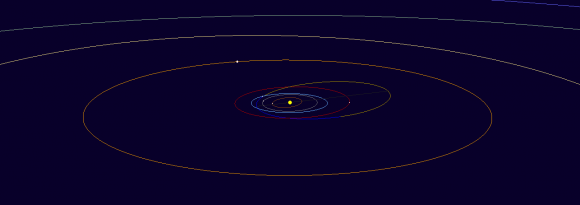
With funding provided by NASA’s Near-Earth Object Observations program, the IAU MPC maintains a centralized database that is responsible for the identification, designation and orbit computations of all the minor planets, comets and outer satellites of the Solar System. Since it’s inception, it has been maintaining information on 16,202 Near-Earth Objects, 729,626 Minor Planets, and 3,976 comets.
But it is the NEOs that are of particular interest, since they periodically make close approaches to Earth. In the case of 2017 HX4, the object has been shown to have an orbital period of 2.37 years, following a path that takes it from beyond the orbit of Venus to well beyond the orbit of Mars. In other words, it orbits our Sun at an average distance (semi-major axis) of 1.776 AU, ranging from about 0.88 AU at perihelion to 2.669 AU at aphelion.
Since it was first spotted, the object has been viewed a total of 41 times between April 26th and May 4th. In addition to the Pan-STARRS-1 survey, observations were also provided by the Cerro Tololo Observatory, the Mauna Kea Observatories, the Steward Observatory and the Kitt Peak-Spacewatch Telescopes, the Astronomical Research Observatory, the Apache Point Observatory, and the Mount John Observatory.
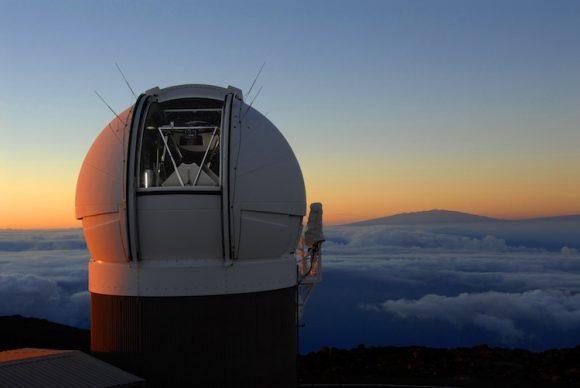
From these combined observations, the IAU MPC was able to compile information on the object’s orbital period, when it would cross Earth’s orbit, and just how close it would come to us in the process. So, as always, there was nothing to worry about here folks. These objects are always spotted before they cross Earth’s orbit, and their paths, periods and velocities and are known about in advance.
Even so, it’s worth noting that an object of this size was nowhere near to be large enough to cause an Extinction Level Event. In fact, the asteroid that struck Earth 65 millions year ago at the end of Cretaceous era – which created the Chicxulub Crater on the Yucatan Peninsula in Mexico and caused the extinction of the dinosaurs – was estimated to measure 10 km across.
At 10 to 33 meters (32.8 to 108 feet), this asteroid would certainly have caused considerable damage if it hit us. But the results would not exactly have been cataclysmic. Still, it might not be too soon to consider getting off this ball of rock. You know, before – as Hawking has warned – a single event is able to claim all of humanity in one fell swoop!
The MPC is currently tracking the 13 NEOs that were discovered during the month of May alone, and that’s just so far. Expect to hear more about rocks that might cross our path in the future.
Further Reading: IAU Minor Planet Center
NASA Invests In Radical Game-Changing Concepts For Exploration
Every year, the NASA Innovative Advanced Concepts (NIAC) program puts out the call to the general public, hoping to find better or entirely new aerospace architectures, systems, or mission ideas. As part of the Space Technology Mission Directorate, this program has been in operation since 1998, serving as a high-level entry point to entrepreneurs, innovators and researchers who want to contribute to human space exploration.
This year, thirteen concepts were chosen for Phase I of the NIAC program, ranging from reprogrammed microorganisms for Mars, a two-dimensional spacecraft that could de-orbit space debris, an analog rover for extreme environments, a robot that turn asteroids into spacecraft, and a next-generation exoplanet hunter. These proposals were awarded $100,000 each for a nine month period to assess the feasibility of their concept.
Continue reading “NASA Invests In Radical Game-Changing Concepts For Exploration”
How Sentinel Will Hunt for Hidden Asteroids
Asteroids of various sizes whiz past our planet all the time. Some we know about, but many we don’t, and new ones are identified on an almost weekly basis. (In fact one such recently-discovered asteroid named 2014 HQ214, an object the length of an aircraft carrier, will pass us at a mere 3 lunar distances today June 8… watch live coverage here.) And, of course, some actually do impact Earth, and if they are large enough the results can be quite… energetic, to put it lightly.
While there aren’t yet any programs in place that can prevent a large asteroid impact from happening, there are some that are at least on the lookout for potential impactors. The B612 Foundation’s privately-funded Sentinel mission is one of them and, once launched and placed in orbit around the Sun in 2018, will hunt for near-Earth asteroids down to about 140 meters in size using the most advanced infrared imaging technology… and no federal budget cuts or red tape to worry about.
The video above, produced by B612 Foundation’s primary contractor Ball Aerospace, shows how Sentinel will work, and why development has been going so well.
“I see this as the wave of the future — the ability for non-governmental organizations to put together the funding, working with outstanding technical organizations like Ball Aerospace, and produce space missions where the government isn’t involved and where the price is much, much less, and we still get the same kind of great information.”
– Dr. Scott Hubbard, B612 Program Architect and former director of the NASA Ames Research Center
A Parting Look at 2012 DA14: Was This a Warning Shot from Space?
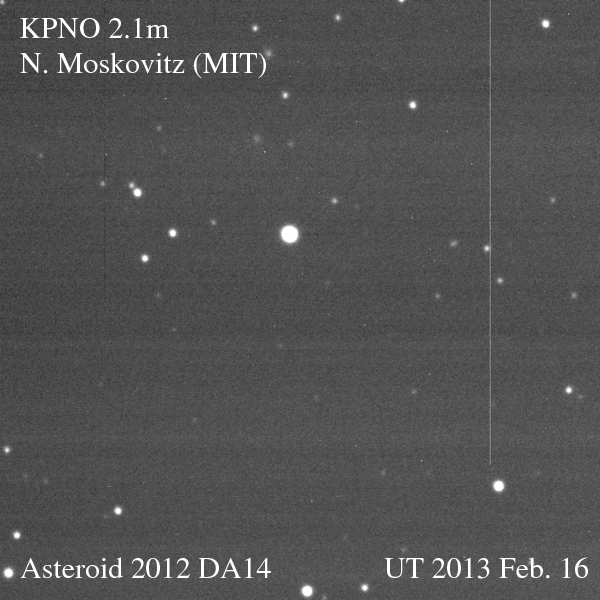
Just as anticipated, on Friday, Feb. 15, asteroid 2012 DA14 passed us by, zipping 27,000 kilometers (17,000 miles) above Earth’s surface — well within the ring of geostationary weather and communications satellites that ring our world. Traveling a breakneck 28,100 km/hr (that’s nearly five miles a second!) the 50-meter space rock was a fast-moving target for professional and amateur observers alike. And even as it was heading away from Earth DA14 was captured on camera by a team led by MIT researcher Dr. Nicholas Moskovitz using the 2.1-meter telescope at the Kitt Peak National Observatory in Tucson, AZ. The team’s images are shown above as an animated gif (you may need to click the image to play it.)
This object’s close pass, coupled with the completely unexpected appearance of a remarkably large meteor in the skies over Chelyabinsk, Russia on the morning of the same day, highlight the need for continued research of near-Earth objects (NEOs) — since there are plenty more out there where these came from.
“Flybys like this, particularly for objects smaller than 2012 DA14, are not uncommon. This one was special because we knew about it well in advance so that observations could be planned to look at how asteroids are effected by the Earth’s gravity when they come so close.”
– Dr. Nicholas Moskovitz, MIT
The animation shows 2012 DA14 passing inside the Little Dipper, crossing an area about a third the size of the full Moon in 45 minutes. North is to the left.
(For a high-resolution version of the animation, click here.)
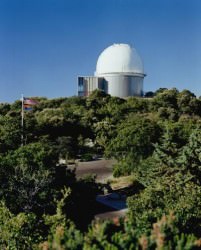
According to the National Optical Astronomy Observatory, which operates the Kitt Peak Observatory, Dr. Moskovitz’ NSF-supported team “are analyzing their data to measure any changes in the rotation rate of the asteroid after its close encounter with the Earth. Although asteroids are generally too small to resolve with optical telescopes, their irregular shape causes their brightness to change as they rotate. Measuring the rotation rate of the asteroid in this way allows the team to test models that predict how the earth’s gravity can affect close-passing asteroids. This will lead to a better understanding of whether objects like 2012 DA14 are rubble piles or single solid rocks.
“This is critical to understanding the potential hazards that other asteroids could pose if they collide with the Earth.”
So just how close was DA14’s “close pass?” Well, if Earth were just a few minutes farther along in its orbit, we would likely be looking at images of its impact rather than its departure.*
Although this particular asteroid isn’t expected to approach Earth so closely at any time in the foreseeable future — at least within the next 130 years — there are lots of such Earth-crossing objects within the inner Solar System… some we’re aware of, but many that we’re not. Identifying them and knowing as many details as possible about their orbits, shapes, and compositions is key.
Even this soon after the Feb. 15 flyby observations of 2012 DA14 have provided more information on its orbit and characteristics., allowing for fine-tuning of the data on it.
According to the Goldstone Radar Observatory web page, the details on 2012 DA14 are as follows:
Semimajor axis 1.002 AU
Eccentricity 0.108
Inclination 10.4 deg
Perihelion distance 0.893 AU
Aphelion distance 1.110 AU
Absolute magnitude (H) 24.4
Diameter ~50 meters (+- a factor of two)
Rotation period ~6 h (N. Moskovitz, pers. comm.)
Pole direction unknown
Lightcurve amplitude ~1 mag (N. Moskovitz, pers. comm.)
Spectral class Ld (N. Moskovitz, pers. comm.)
Goldstone is currently conducting radar observations on the asteroid. A radar map of its surface and motion is anticipated in the near future.
Read more about Dr. Moskovitz’ observations on the NOAO website here, and see more images of 2012 DA14 captured by astronomers around the world in our previous article.
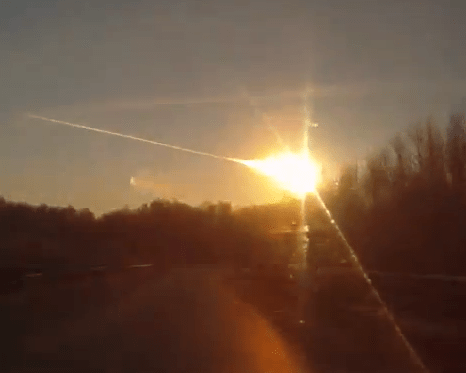
Also, in an encouraging move by international leaders in the field, during the fiftieth session of the Scientific and Technical Subcommittee of the Committee on the Peaceful Uses of Outer Space, currently being held from at the United Nation Office in Vienna, near-Earth objects are on the agenda with a final report to be issued by an Action Team. Read the report PDF here.
*According to astronomer Phil Plait, while the orbits of Earth and DA14 might intersect at some point, on the 15th of February 2013 the asteroid slipped just outside of Earth’s orbit — a little over 17,000 miles shy. “It was traveling one way and the Earth another, so they could not have hit each other on this pass no matter where Earth was in its orbit,” he wrote in an email. Still, 17,000 miles is a very close call astronomically, and according to Neil deGrasse Tyson on Twitter, it “will one day hit us, like the one in Russian [sic] last night.” When? We don’t know yet. That’s why we must keep watching.



